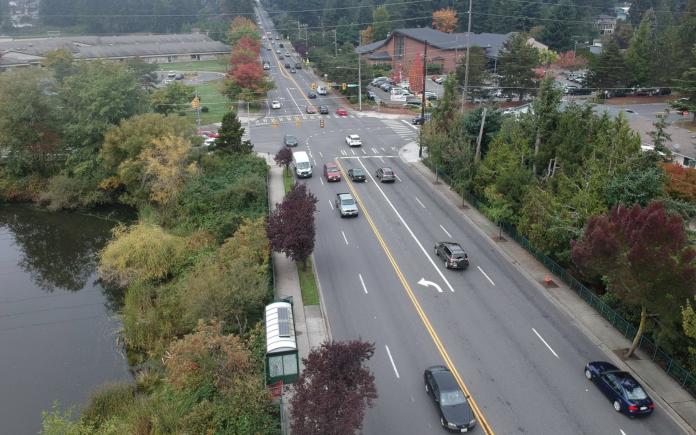
The City of Shoreline will not go back to the drawing board to rethink a long-planned major street redesign even after an outcry over plans to remove 274 trees prompted a public meeting this week. The project along N 175th Street is set to widen the roadway to add expanded sidewalks and space for people to safely bike while at the same time adding vehicle capacity for drivers in the vicinity of I-5. Construction is scheduled to start next year, but groups like Save Shoreline Trees have geared up to fight the plan.
Despite the pushback, the Shoreline City Council was in near consensus at Monday’s meeting that they should stay the course and move forward with the first phase of the revamp of 175th Street between I-5 and Meridian Avenue N. That phase is fully funded but dependent on outside funding, and a reassessment could disrupt the project’s timeline. For the project’s future phases, which will ultimately connect I-5 to Stone Ave N and the Interurban Trail, the council did ask staff to take another look at design elements that might allow preservation of additional trees.
However, the council expressed very little willingness to do what many tree advocates were requesting — to jettison safe space for people biking from most of the project and reduce space for walking and rolling.

Save Shoreline Trees, a volunteer organization dedicated to “the preservation of our tall conifer and native tree canopy in Shoreline,” has called the planned sidewalks “too wide” and instead proposed routing people on bikes onto N 178th Street. The group supports narrowing the planned sidewalks to a minimum five-foot ADA standard on either side of 175th Street and removing roadway medians from the design, even though those medians would see new trees planted in them. Save Shoreline Trees alleges the median trees would do nothing to shade the area overall.
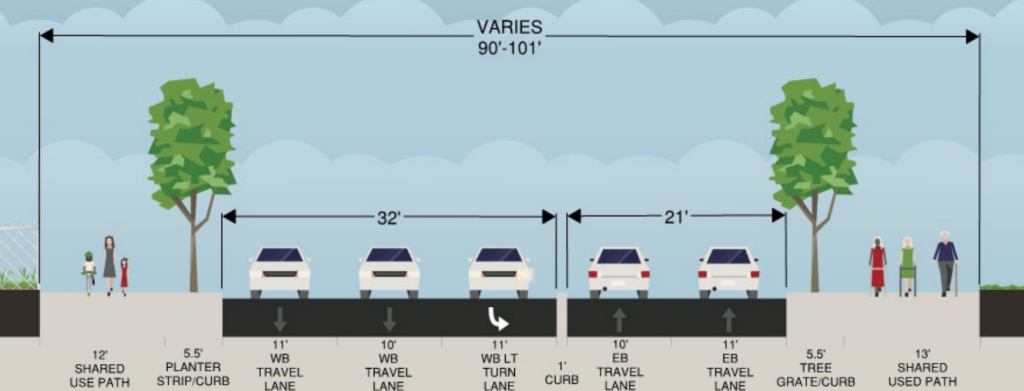
“Moving the bike lanes off of 175th and onto 178th between the Interurban Trail and Meridian Ave N would create a much more pleasant ride for bicyclists, allow more space for cars on N 175th, and help save existing trees,” Ruth Williams, president of the Thornton Creek Alliance, wrote to the council this week in supporting the changes proposed by Save Shoreline Trees.
Detouring people biking onto a parallel route is actually a tactic that Shoreline is employing further south, as part of another major corridor upgrade along N 145th Street at the Seattle city limit. Forcing people to use indirect bike routes reduces the attractiveness of biking as a mode of travel and sabotages the city’s efforts to reduce reliance on cars.
A majority of Shoreline councilmembers were not willing to go along with watering down multimodal upgrades intended to give Shoreline easier access to and from the city’s two light rail stations, which will open on August 30. Shoreline has been permitting new housing around transit at a rate that’s close to unprecedented for a city of its size, approving more than 4,000 new homes since 2019, a number that is set to increase the city’s housing stock by nearly 20%.
“It provides convenient and easy access to forms of public transportation that don’t emit greenhouse gases,” Councilmember Jon Ramsdell said. “We have a light rail system right now that has zero net GHG gases, and we have a responsibility as a community, I feel like we have to make access to that form of transportation as easy as possible.”
Ramsdell touted the potential that will come when 175th Street connects directly with a planned multi-use path along I-5 that Shoreline is planning now, called the Trail Along the Rail. But even without that project, an upgrade to 175th Street will really change how people are able to get around Shoreline without a car.
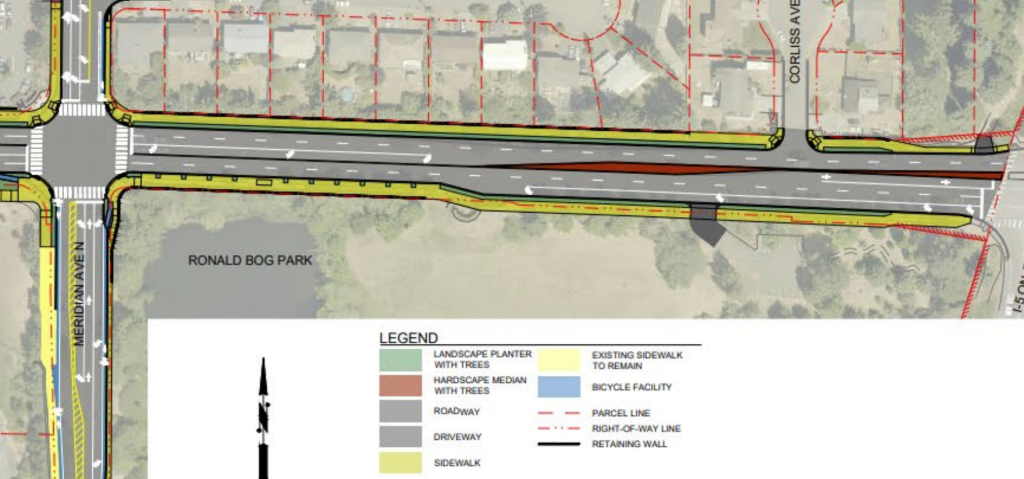
Councilmember Betsy Robertson, in a written statement read by a colleague in her absence, argued that the trees along 175th Street did not individually rise the the level of necessary preservation, and argued that their removal will be in the greater good.
“I don’t want to be cast as someone who is against trees. For example, I desperately want to save the giant sequoia off Firlands Way. But that’s not what’s being lost on 175th, not by a long shot,” Robertson said. “Is there a cumulative effort to the loss of smaller trees? Yes, of course, but there are other cumulative efforts that we must consider as policymakers in Shoreline. We have a responsibility to our community members right now, as well as in the next years and generations. We can and are making better policy decisions than the generations of leaders who came before us.”
One councilmember did seem willing to sacrifice biking and walking space along 175th in order to save trees, newly elected Annette Ademasu. “Let’s do a redesign. It can be a win/win situation for the safety of our residents and children, and protection of our natural environment,” Ademasu said.
But staff said that an attempt to take away the bike component of the project may make the city much less competitive for the types of grants that they’d like to go after, given the fact that the future phases for 175th Street are largely unfunded right now.
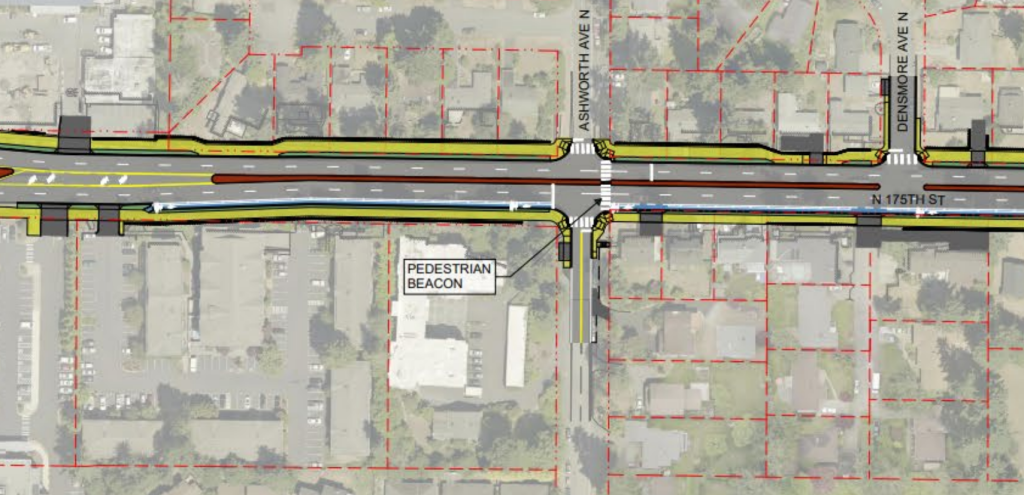
This isn’t the first time that multimodal improvements have come into conflict with tree preservationists in Shoreline. A plan to upgrade sidewalks along 15th Avenue NE, repairing them and adding curb ramps, received pushback over the removal of 18 trees, with an in-person protest happening along the street last year. Nonetheless, Shoreline moved forward with the project. The 145th Street redesign has also come under criticism for tree removal.
At Monday’s meeting, Shoreline Mayor Chris Roberts actually went so far as to suggest that the City should look at reducing the number of travel lanes along future phases of the 175th Street project away from I-5.
“Regardless of whether individuals wanted to save trees or to make sure we have a complete street with protected bike lanes, I didn’t hear one person here saying we need four lanes between Meridian and Midvale,” Roberts said. “If we were to get to one lane in each direction, not only would we reduce traffic speeds, we would make it easier for pedestrians to cross two lanes of traffic instead of four lanes of traffic.”
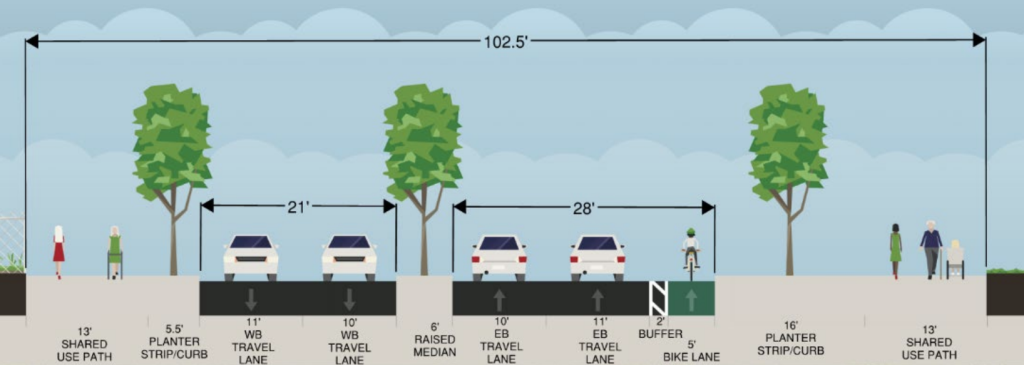
Councilmember Keith Scully, referencing a debate that occurred in Shoreline over a rechannelization of 175th Street along a different segment, urged city staff to not spend too much time looking at reducing the roadway space. “There’s a lot of truck traffic there and car traffic there, and I just don’t — I wish — I don’t see that as happening,” he said.
Scully’s remarks were reinforced by Shoreline’s Public Works Director Tricia Juhnke, who noted the corridor sees over 30,000 trips per day — above the threshold for a “road diet” she placed at 20,000 trips per day. And while this is a multimodal project, another major impetus for the redesign is to increase the speed of vehicles getting through key intersections by adding additional capacity.
“This is partially driven by increased level of service [standards], and I just don’t think we can get the capacity through the intersection,” Juhnke said.
With the idea of reallocating road space away from cars remaining a non-starter — at least for now — the next best alternative seems to be moving forward with the entire project, including the significantly improved biking and walking facilities. With the goal of helping people get around Shoreline without needing to have a car, city leaders appear capable of seeing the forest for the trees.
Ryan Packer has been writing for The Urbanist since 2015, and currently reports full-time as Contributing Editor. Their beats are transportation, land use, public space, traffic safety, and obscure community meetings. Packer has also reported for other regional outlets including BikePortland, Seattle Met, and PubliCola. They live in the Capitol Hill neighborhood of Seattle.

